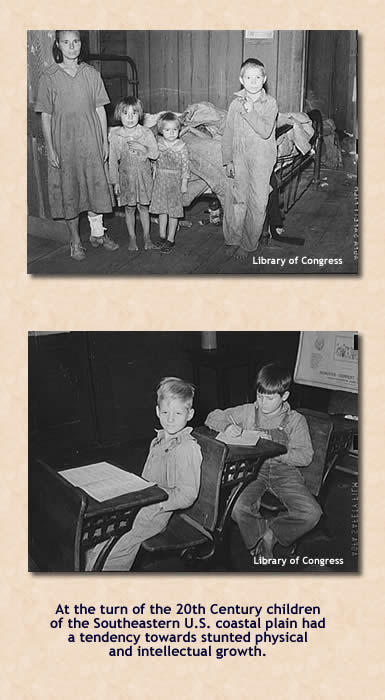Infectious Diseases Case of the Month Case #25 |
|||
 |
4th of July Special EditionAs in previous years, a "Case of the Month" from United States history is presented to celebrate the 4th! At the turn of the twentieth century the United States South was still recovering from the Civil War. Although the "New South" had been proclaimed, the region in general contained areas of severe poverty and remained dependent upon agriculture. Southern agriculture, unfortunately, was the least productive in the United States. Public health and public education resources were weak to non-existant across the region. Both black and white races suffered but blacks particularly so. In its 1896 ruling Plessy v Ferguson the United States Supreme Court codified "separate but equal" accomodations on railroad cars. In practice with a variety of "Jim Crow" laws, southern states applied these segregation practices to all aspects of public life. In part for these reasons illiteracy was particularly prevalent among southern blacks (50% vs 12% for whites). Beyond black poverty, illiteracy, and disenfranchisement there also existed the grim image of the white "cracker," - individuals with sallow skin, bare feet, scrawny necks, protuberant abdomens, retarded intelligence, and shiftless habits. Within the South itself, one region suffered in even more desperate poverty than others. On the southern coastal plain, a region of sandy soils created by the remnants of an ancient sea, people lived in shanties, without sanitation, and existed by subsistence farming. Children growing up on the southern coastal plain seemed particularly listless and apathetic, sallow of complexion, of stunted growth and intellectually dull. Performance and attendance at school could be poor. Observers from outside the region were apt to attribute some sort of innate laziness and ignorance to the region's population. Public health authorities, however, came to suspect a medical etiology for the physical and intellectual deficiencies that could be observed in many of those in the region. |
||
What medical etiology contributed to this region's difficulties? |
|||
 |
Many southern families were suffering from infection from Necatur americanus or hookworm. Hookworm as a cause of human disease had been described in Europe in the 19th century, but in general American physicians were unaware of this helminthic pathogen. However at roughly the turn of the 20th century, certain U.S. scientists, particularly Dr. Charles Stiles, a German trained zoologist, began to suspect that this disease was very prevalent in regions of the South. His pleas to investigate and intervene in this likely illness met indifference, if not ridicule, until the philanthropic stewards of the Rockefeller fortune became aware of the problem. Established in 1909 the Rockefeller Sanitary Commission to Eradicate Hookworm began a remarkable public health intervention to attempt to decrease the burden of this disease. Initial surveys of hookworm disease were conducted, and in 600 southern counties surveyed rates of hookworm infection in children were found to be 40%. An estimated 7.5 million southerners were likely infected. Through deft navigation of Southern political and emotional sensibilities the Sanitary Commission embarked on a campaign to reduce the prevalence of hookworm disease. It promoted physician education and improved sanitation, sponsored state laboratories capable of identifying hookworm larvae, and created traveling dispensaries of deworming agents (thymol). In its five year existence (1909-1914) activities of the Sanitary Commission resulted in a dramatic reduction in the prevalence of hookworm disease in the South leading to significant improvement in children's health, school attendance, and literacy. It led directly to establishment of county and state departments of public health and was the forerunner to the Rockefeller Foundation and its International Health Board which pursued international health issues. Reviled by many for his business practices and his accumulation of great wealth, John D. Rockefeller made great philanthropic gifts to education and health. Charitable giving had been a lifelong habit of Rockefeller even preceding his achievement of wealth. Ironically, despite his personal preference for homeopathy, much of his philanthropy funded medical research and allopathic medical education. His legacy continues to this day. Hookworm continues to be a cause of human disease today in many parts of the world. Its morbidity relates to the severe iron deficiency and attendant problems that can occur in persons heavily infected. For more details and a schematic of the hookworm lifecycle, click here. Necatur americanus was not the only cause of the lassitude and poor health of persons in the southern U.S. in the first years of the 20th century. Malaria was present at levels that would be considered highly prevalent in areas of the world where malaria is found today. Nutritional disorders (pellagra) were also prevalent. Poverty and these illnesses served to perpetuate each other. Only further public health interventions, DDT, and eventual prosperity, in part due to the events of World War II, led to the breaking of these cycles. Ref: Wilcox, L.S. Worms and Germs, Drink and Dementia: US Health, Society, and Policy in the Early 20th Century, Prev Chronic Dis. 2008 October; 5(4): A135 |
||
| Home Case of the Month ID Case Archive | Your Comments/Feedback | ||